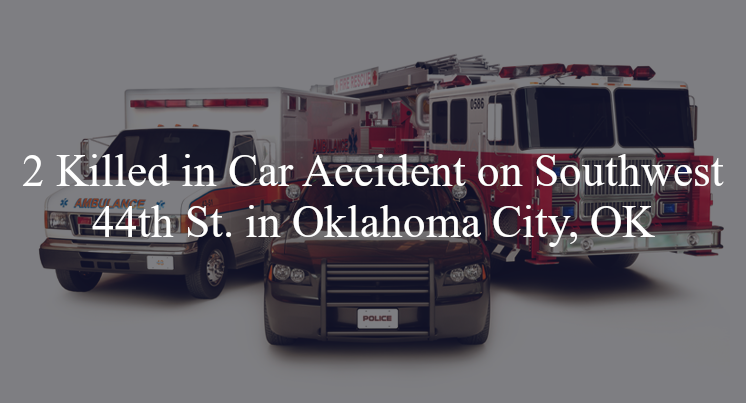2 Killed in Car Accident on Southwest 44th St. in Oklahoma City, OK
Oklahoma City, OK — April 13, 2025, Two people were killed following a car accident that occurred at around 2:30 A.M. on SW 44th St.

An investigation is underway following a car accident that left two people dead during the early morning hours of April 13th. According to official reports, two people were as traveling in a Chevy pickup truck was involved in a a collision in a residential neighborhood and fled after the impact, reportedly running multiple stop signs. When the truck entered the area of Southwest 44th Street and Rancho Drive it struck a wrecker, which then caught fire.
When first responders arrived on the scene, they found that the driver and passenger of the truck had sustained serious injuries and they were transported to the hospital for treatment where they later died. At this time there has been no further information released from the accident, including the identities of those involved, however this remains an ongoing investigation and more details may be released by authorities in the future.
Commentary
When a vehicle is involved in multiple incidents—initially fleeing a collision, reportedly running stop signs, and ultimately striking another vehicle that ignites—it raises serious questions not just about the behavior of the driver, but also about the broader sequence of events that led to a fatal outcome. To fully understand what occurred and whether there were contributing factors beyond human error, it’s critical to ask three guiding questions: Did the authorities conduct a thorough and complete investigation? Has anyone examined whether a vehicle defect or malfunction played a role in the crash or its aftermath? And has all available electronic data from the involved vehicles been collected?
First, a comprehensive investigation is essential. A crash that follows a hit-and-run and results in fatalities must be treated as a multi-scene incident. Investigators should reconstruct the timeline from the initial impact through to the final collision, identifying how fast the vehicle was traveling, which intersections were crossed, and whether any evasive maneuvers were attempted. The fact that the truck reportedly ran multiple stop signs suggests a loss of control or failure to respond to traffic conditions—an issue that could stem from more than just driver decision-making. Every stage of the vehicle’s movement needs to be understood through careful documentation and scene analysis.
Second, while the driver’s actions may be a focus, it’s equally important to examine whether the vehicle itself functioned as intended. Did the brakes fail during or after the initial crash? Was there a mechanical issue that prevented the vehicle from slowing or stopping? In cases involving collisions and fire, questions must also be asked about the structural integrity of the fuel system. If the wrecker ignited upon impact, it’s important to determine whether that fire was the result of an expected mechanical outcome or a failure of a safety component designed to prevent such an event. These issues often go unaddressed unless a deliberate vehicle inspection is conducted before evidence is lost.
Lastly, electronic data can offer insight into exactly how both vehicles performed in the final moments before impact. The Chevy pickup likely contains an electronic control module (ECM) that may record speed, braking activity, throttle input, and seatbelt use. If this data is retrieved, it could help clarify whether the driver attempted to regain control or whether the vehicle experienced a system failure. Similarly, data from the wrecker—if it has an ECM—could provide context for how the collision occurred and how the vehicle responded. Investigators should also seek any available surveillance footage or mobile data to establish location and movement patterns throughout the incident.
In cases involving multiple impacts, serious injuries, and fire, a surface-level understanding is not sufficient. Only by conducting a full investigation, examining possible vehicle failures, and collecting all available electronic and physical evidence can we begin to piece together what happened. These steps are essential—not just to understand the past, but to inform safety decisions moving forward.

*We appreciate your feedback and welcome anyone to comment on our blog entries, however all visitor blog comments must be approved by the site moderator prior to showing live on the site. By submitting a blog comment you acknowledge that your post may appear live on the site for any visitors to see, pending moderator approval. The operators of this site are not responsible for the accuracy or content of the comments made by site visitors. By submitting a comment, blog post, or email to this site you acknowledge that you may receive a response with regard to your questions or concerns. If you contact Grossman Law Offices using this online form, your message will not create an attorney-client relationship and will not necessarily be treated as privileged or confidential! You should not send sensitive or confidential information via the Internet. Since the Internet is not necessarily a secure environment, it is not possible to ensure that your message sent via the Internet might be kept secure and confidential. When you fill out a contact or comment form, send us an email directly, initiate a chat session or call us, you acknowledge we may use your contact information to communicate with you in the future for marketing purposes, but such marketing will always be done in an ethical way.